Bakir Lacevic
Real-Time Sampling-Based Safe Motion Planning for Robotic Manipulators in Dynamic Environments
Dec 31, 2024Abstract:In this paper, we present the main features of Dynamic Rapidly-exploring Generalized Bur Tree (DRGBT) algorithm, a sampling-based planner for dynamic environments. We provide a detailed time analysis and appropriate scheduling to facilitate a real-time operation. To this end, an extensive analysis is conducted to identify the time-critical routines and their dependence on the number of obstacles. Furthermore, information about the distance to obstacles is used to compute a structure called dynamic expanded bubble of free configuration space, which is then utilized to establish sufficient conditions for a guaranteed safe motion of the robot while satisfying all kinematic constraints. An extensive randomized simulation trial is conducted to compare the proposed algorithm to a competing state-of-the-art method. Finally, an experimental study on a real robot is carried out covering a variety of scenarios including those with human presence. The results show the effectiveness and feasibility of real-time execution of the proposed motion planning algorithm within a typical sensor-based arrangement, using cheap hardware and sequential architecture, without the necessity for GPUs or heavy parallelization.
SLOPE: Search with Learned Optimal Pruning-based Expansion
Jun 07, 2024Abstract:Heuristic search is often used for motion planning and pathfinding problems, for finding the shortest path in a graph while also promising completeness and optimal efficiency. The drawback is it's space complexity, specifically storing all expanded child nodes in memory and sorting large lists of active nodes, which can be a problem in real-time scenarios with limited on-board computation. To combat this, we present the Search with Learned Optimal Pruning-based Expansion (SLOPE), which, learns the distance of a node from a possible optimal path, unlike other approaches that learn a cost-to-go value. The unfavored nodes are then pruned according to the said distance, which in turn reduces the size of the open list. This ensures that the search explores only the region close to optimal paths while lowering memory and computational costs. Unlike traditional learning methods, our approach is orthogonal to estimating cost-to-go heuristics, offering a complementary strategy for improving search efficiency. We demonstrate the effectiveness of our approach evaluating it as a standalone search method and in conjunction with learned heuristic functions, achieving comparable-or-better node expansion metrics, while lowering the number of child nodes in the open list. Our code is available at https://github.com/dbokan1/SLOPE.
Octocopter Design: Modelling, Control and Motion Planning
Dec 02, 2022Abstract:This book provides a solution to the control and motion planning design for an octocopter system. It includes a particular choice of control and motion planning algorithms which is based on the authors' previous research work, so it can be used as a reference design guidance for students, researchers as well as autonomous vehicles hobbyists. The control is constructed based on a fault tolerant approach aiming to increase the chances of the system to detect and isolate a potential failure in order to produce feasible control signals to the remaining active motors. The used motion planning algorithm is risk-aware by means that it takes into account the constraints related to the fault-dependant and mission-related maneuverability analysis of the octocopter system during the planning stage. Such a planner generates only those reference trajectories along which the octocopter system would be safe and capable of good tracking in case of a single motor fault and of majority of double motor fault scenarios. The control and motion planning algorithms presented in the book aim to increase the overall reliability of the system for completing the mission.
A novel approach to model exploration for value function learning
Jun 06, 2019

Abstract:Planning and Learning are complementary approaches. Planning relies on deliberative reasoning about the current state and sequence of future reachable states to solve the problem. Learning, on the other hand, is focused on improving system performance based on experience or available data. Learning to improve the performance of planning based on experience in similar, previously solved problems, is ongoing research. One approach is to learn Value function (cost-to-go) which can be used as heuristics for speeding up search-based planning. Existing approaches in this direction use the results of the previous search for learning the heuristics. In this work, we present a search-inspired approach of systematic model exploration for the learning of the value function which does not stop when a plan is available but rather prolongs search such that not only resulting optimal path is used but also extended region around the optimal path. This, in turn, improves both the efficiency and robustness of successive planning. Additionally, the effect of losing admissibility by using ML heuristic is managed by bounding ML with other admissible heuristics.
Search-based optimal motion planning for automated driving
Aug 03, 2018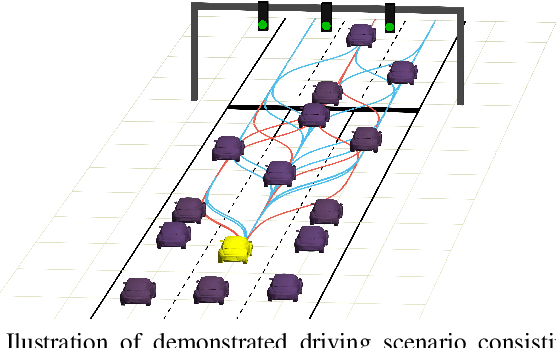
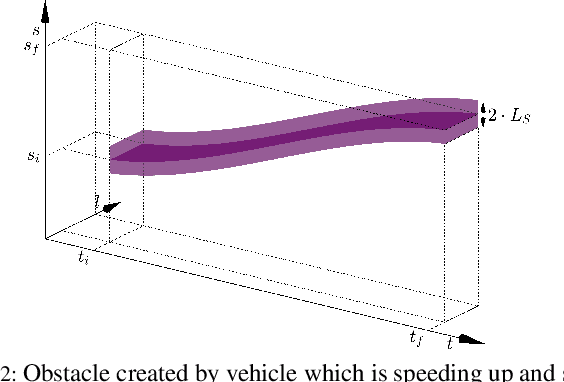
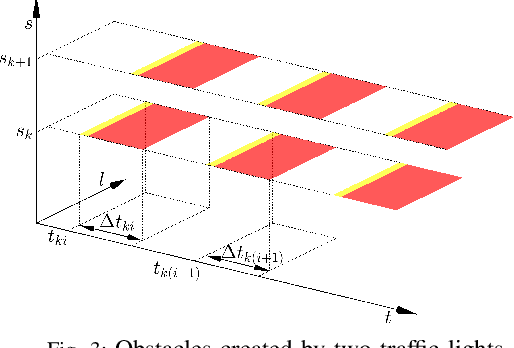
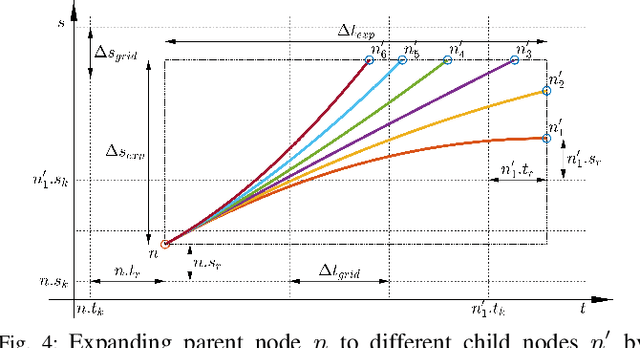
Abstract:This paper presents a framework for fast and robust motion planning designed to facilitate automated driving. The framework allows for real-time computation even for horizons of several hundred meters and thus enabling automated driving in urban conditions. This is achieved through several features. Firstly, a convenient geometrical representation of both the search space and driving constraints enables the use of classical path planning approach. Thus, a wide variety of constraints can be tackled simultaneously (other vehicles, traffic lights, etc.). Secondly, an exact cost-to-go map, obtained by solving a relaxed problem, is then used by A*-based algorithm with model predictive flavour in order to compute the optimal motion trajectory. The algorithm takes into account both distance and time horizons. The approach is validated within a simulation study with realistic traffic scenarios. We demonstrate the capability of the algorithm to devise plans both in fast and slow driving conditions, even when full stop is required.
Safe learning-based optimal motion planning for automated driving
Jun 13, 2018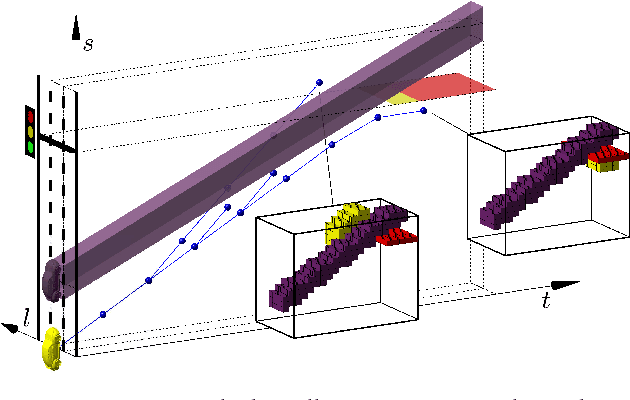
Abstract:This paper presents preliminary work on learning the search heuristic for the optimal motion planning for automated driving in urban traffic. Previous work considered search-based optimal motion planning framework (SBOMP) that utilized numerical or model-based heuristics that did not consider dynamic obstacles. Optimal solution was still guaranteed since dynamic obstacles can only increase the cost. However, significant variations in the search efficiency are observed depending whether dynamic obstacles are present or not. This paper introduces machine learning (ML) based heuristic that takes into account dynamic obstacles, thus adding to the performance consistency for achieving real-time implementation.
 Add to Chrome
Add to Chrome Add to Firefox
Add to Firefox Add to Edge
Add to Edge